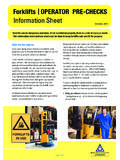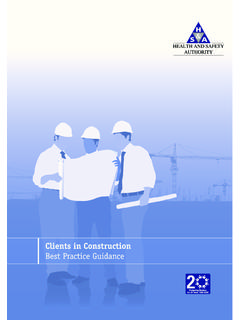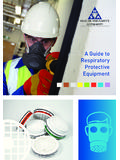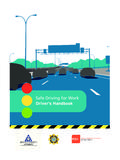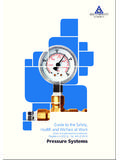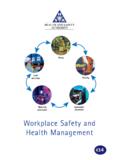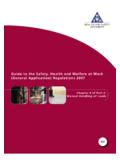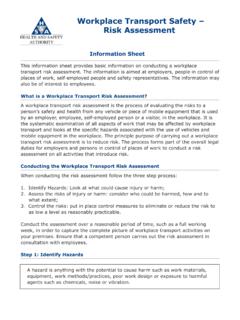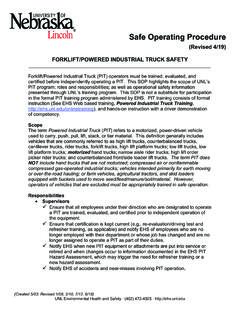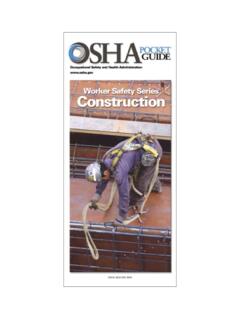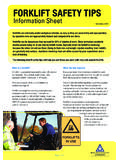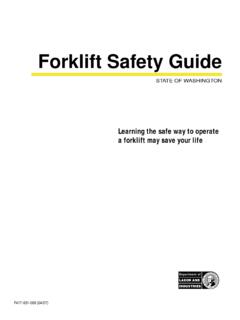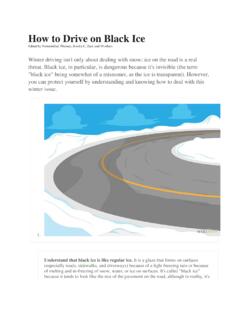Transcription of Transport and Storage - Health and Safety Authority
1 Guide on Manual HandlingRisk Management in Transport andStorageOur vision: A country where workersafety, Health and welfareand the safe managementof chemicals are central tosuccessful enterpriseINTRODUCTION ..2 THE BUSINESS CASE FOR MANAGING MANUAL HANDLING IN THE Transport AND Storage SECTOR ..4 WHY IS THERE A NEED TO MANAGE THE HAZARD OF MANUAL HANDLING IN THE WORKPLACE? ..5 THE MANUAL HANDLING RISK ASSESSMENT PROCESS ..8 APPENDIX 1: MANUAL HANDLING RISK ASSESSMENT WORKSHEET (COMPLETED) ..14 APPENDIX 2: MANUAL HANDLING RISK ASSESSMENT WORKSHEET (BLANK) ..15 APPENDIX 3: PRE DELIVERY RISK ASSESSMENT WORKSHEET ..17 APPENDIX 4: EXAMPLES OF RISK FACTORS FOR MANUAL HANDLING OF GOODS ..19 APPENDIX 5: Safety AND MANUAL HANDLING TIPS FOR DRIVERS ..20 ContentsPublished in 2013 by the Health and Safety Authority , The Metropolitan Building, James Joyce Street, Dublin 1.
2 Guide on Manual Handling Risk Management in Transport and StorageINTRODUCTIONThis guide gives practical information on actions that can be taken to manage the potential hazard ofmanual handling in Transport and Storage . It underlines the importance of taking an in-depth look atcurrent work practices to identify potentially hazardous manual handling and, in consultation with staff,developing improved systems of work which will reduce unsafe manual handling. It is specifically focusedon those work activities in Transport and Storage which involve loading and unloading of materials toand from vehicles. Below are some examples of vehicles used to Transport materials: Vans: Deliveries of materials are typically offloaded from trucks and placed in temporary hold areas in depots for cross docking.
3 Drivers transfer goods and materials into their vans. Typically these are individual items of various sizes and not on pallets. They are transferred to the van by hand [hand balling] or using a hand truck . Rigid Trucks: Typically used for delivering and collecting goods on pallets or in roll cages. They include, for example, delivery of goods to hospitality sector, retailers, hospitals or Storage facilities. Articulated heavy goods vehicles [HGV s]:Typically used to Transport goods on a larger scale. Such as full pallets of goods to large warehouses, Storage or distribution centres. Goods are often loaded or unloaded using pallet trucks on a tail lift or by is an example of a typical mechanical handling activity, where a pallet is being unloaded from atruck using a tail type of vehicles used in Transport operations range from small vans to rigid trucks (> tonnes) toarticulated heavy goods vehicles(> tonnes).
4 In 2010 there were 95,800 peopleworking in the Transport and storagesector in Ireland (HSA AnnualStatistics Report 2011). Recent figuresproduced by the Health and SafetyAuthority underline the prevalenceof injury in the sector due toineffective management of thehazard of manual handling. The tablebelow indicates that, in 2012, injuriesrelated to manual handlingaccounted for 40% of all reportedinjuries at work in this 2 Guide on Manual Handling Risk Management in Transport and StorageExamples of the issues that contribute to ineffective management of the hazard of manual handlinginclude the lack of safe systems of work for handling of very heavy loads, no labelling of weightinformation on product, the lack of planning for delivery of loads to clients, the unavailability of handlingaids and the lack of instruction and guide will provide employers involved in Transport and logistics with a risk assessment tool tomanage the hazard of manual handling in order to prevent manual handling injuries at work and toreduce exposure to business costs associated with manual handling objectives of this guide are.
5 To raise awareness of the business case for managing the hazard of manual handling To explain why the hazard of manual handling needs to be managed in the workplace To help employers understand and recognise what the potential risk factors are in relation to manual handling in their workplace To give direction on manual handling risk assessment and how it can be used to highlight potential hazards and create opportunities for developing better ways of working, including use of handling aids, improved housekeeping or better organisation of work processes, resulting in reduced handling of stock and reduced risk of musculoskeletal injury-To explain the manual handling risk assessment process through illustrated case studies-To give direction on developing a safe system of work for a manual handling activityPage 3 Guide on Manual Handling Risk Management in Transport and Storage200820092010201120120%5%10%15%20% 25%30%35%40%Manual HandlingFall on same level(slip, stumble etc)Loss of control of meansof Transport or handlingequipmentBody movement(no physical stress)
6 All other triggersNon-fatal injuries by accident trigger [as percentage of total] reported to the HSA from Transport and Storage SectorPage 4 Guide on Manual Handling Risk Management in Transport and StorageTHE BUSINESS CASE FOR MANAGING MANUAL HANDLING IN THE Transport AND Storage SECTORThe 2012 Health and Safety Authority figures for non-fatal injuries in the Transport and Storage sectorshow that over 40% of all non-fatal injuries were sprain/strain due to physical strain on the musculoskeletalsystem, resulting from unsafe systems of work for handling loads. Further analysis of this data shows that thetotal lost work days due to sprain/strain injuries was 11,504 or thirty one lost work years. According to a report produced by the European Agency for Health and Safety at Work there are somecommon risk factors that can increase the likelihood of musculoskeletal injury when carrying out manualhandling activities in the Transport and Storage sector.
7 These include: Lack of planned systems of work for the handling of heavy loads during the loading and unloading of vehicles, lack of access within a van when unloading, or poor housekeeping. Mechanical handling aids not being made available in the workplace, every delivery vehicle should be supplied with an appropriate handling aid, a stair climber, sack truck or hand pallet truck Lack of planning for delivery of loads which are unwieldy and difficult to handle Lack of arrangements with clients to ensure safe delivery of loads on site, when a driver arrives on site and has to transfer loads over a long distance due to the lack of parking close to the intended delivery point Increased worker fatigue due to a number of factors, including longer shifts, more frequent deliveries and poor layout of loads in the vehicle Lack of opportunity for dynamic movement during the work shift.
8 Sitting for long periods of time with little opportunity for variation of movementThese risk factors can be addressed. There is an opportunity for employers to develop appropriatesolutions in consultation with staff to address these issues, reduce the risk of musculoskeletal injury andreduce the costs to business. The economic costs of musculoskeletal injury to the Transport and Storage sector include the following: The cost of absence from work: according to data supplied by the Department of Social Protection, theaverage length of absence for a back injury at work is forty-nine days, or almost 10 weeks, a significant financial burden for a typical Transport and Storage business. The cost of reduced productivity: although this may be more difficult to measure, it is a cost an injuryon-site will result in delays in meeting client requirements which can impact on quality performance and goodwill.
9 Cost of accident investigation by the company itself, insurance bodies or statutory agencies such as the Health and Safety Authority . The cost of compensation claims, whether through the courts or the Injuries board. Below are some examples of compensation claims that were awarded to workers in the Transport andstorage sector due to ineffective management of the hazard of manual injuries in the Transport and Storage sector are a massive drain on the resources of anemployer. They can incur costs such as sick pay and legal and injury benefit, and can lead to lost produc-tivity and the need for retraining, which can be time-consuming and costly. They represent a substantialopportunity for cost reduction, since they can be managed through the implementation of an effectivemanual handling risk management processWHY IS THERE IS A NEED TO MANAGE THE HAZARD OF MANUAL HANDLING IN THE WORKPLACE?
10 In the Transport and Storage sector manual handling forms a significantpart of work activities. The work activity may involve lifting very heavy loads or require repeti-tive bending during a lifting activity. If the hazard of manual handling isnot addressed, these activities could result in injuries including discdamage or ligament damage in the back. The Safety , Health and Welfare at Work (General Application)Regulations 2007 (SI No. 299 of 2007), Chapter 4 of Part 2, outlines therequirements that employers must adhere to in relation to 5 Guide on Manual Handling Risk Management in Transport and StorageIssueA worker was injured while lifting a heavy mattressup a stairwellEmployee was injured while lifting a trailer intoplaceEmployee injured his back while delivering a fridgeOutcomeA settlement was made for 27,000 A settlement was made for 39,000 A settlement was made for 31,000 Manual handling is defined in Regulation 68 of the Safety , Health and Welfare at Work (GeneralApplication) Regulations 2007.
